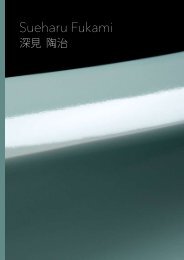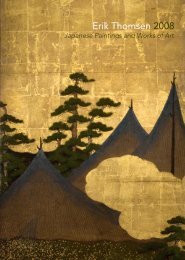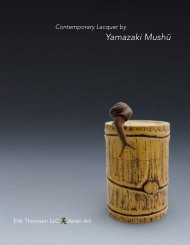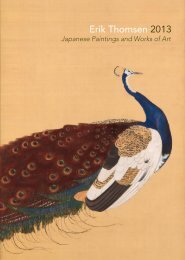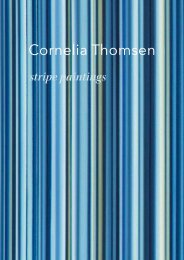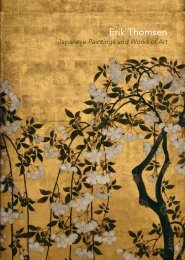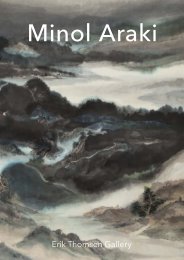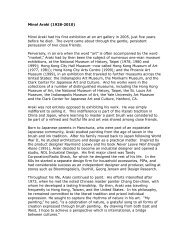View publication (pdf file 6.5 mb) - Erik Thomsen
View publication (pdf file 6.5 mb) - Erik Thomsen
View publication (pdf file 6.5 mb) - Erik Thomsen
- No tags were found...
Create successful ePaper yourself
Turn your PDF publications into a flip-book with our unique Google optimized e-Paper software.
15Hirai Baisen 平 井 楳 仙 (1889 –1969)The Snow of Kamogawa River 鴨 川 の 雪Taishō Period (1912 – 26), dated 1917H 50" × W 16 ½" (incl. mounting 85" × 22")(126.7 cm × 41.9 cm, 216 cm × 55.8 cm)Hanging scroll, ink, colors and gofun on silkPainting signature: »Painted by Baisen« 楳 仙 画Painting seal: Baisen 楳 仙Box inscription, top:»The Snow of Kamogawa River« 鴨 川 の 雪Box inscription, inside:»Painted by Baisen on a spring day in 1917.Titled by the artist himself« 丁 巳 春 日 作 楳 仙 自 題Seal: Baisen 楳 仙Box inscription, end:»By the brush of Baisen. Painting of Snow and KamogawaRiver. Matsubara Miyagawa 7-chō. Colorson silk. Matched box«松 原 宮 川 七 丁 楳 仙 筆 鴨 川 雪 の 図 着 色 絹 本共 箱 七 丁It is a winter day with falling snow, the sky darkeningin the late afternoon. We see a footbridge, theMatsubara Bridge, crossing the Kamogawa Riverin Kyoto, to the south of Shijō Street. 1 Outlinedagainst the sky are the Higashiyama mountains onthe eastern side of Kyoto. On the far side of the riverare the teahouses of the Gion entertainment district.The two travelers on the footbridge are headingtoward Gion, perhaps customers preparing tovisit a favorite establishment or perhaps the geishagetting ready for that evening’s performance.The site, the Kamogawa River and the teahousesalong its banks, has long been one of the famoussights of Kyoto. This was the case in the 16th/17thcentury Rakuchū rakugaizu screens and was stillthe case in the time of Hirai Baisen. Further viewsof the area are included in the three albums thatBaisen composed for the tenth Bunten Exhibitionin 1916, depicting thirty different views of Kyoto,entitled Miyako sanjukkei. 2 Interestingly, Baisen alsopainted the Higashiyama mountains of the areaon a pair of monumental landscape screens duringthe late Taishō period, using similar techniques. 3Clearly the artist had no difficulties in adjusting hiscompositions to different scales and formats.The artist was known for his remarkable changes instyle and subject matter. His return from a trip toChina in 1913 inaugurated a period during which hecreated ink landscape paintings of Chinese mountainsand pagodas. 4 Later yet, his attention returnedto Japan and he went into a period of brilliant recreationsof his hometown, Kyoto. Not only did histheme and subject matter change, but so did histechniques and materials used. In place of ink andpaper, he later used silk and heavy Nihonga-stylepigments of mineral colors and gofun, a powderderived from seashells.Baisen was particularly adapt in the use of gofun,which, because of its thick and inflexible consistancy,can be difficult to use and tends to flake off.For this painting, Baisen prepared layers of gofunon the front as well as on the back of the silk. Usingthe white material on both sides of the silk 5 madeit possible to show various shades of white andimpart a sense of depth to the colors. It also makesthe gofun snowflakes stand out more againstthe fine ink wash and gives a feel of looking at alandscape through falling snow. 6Baisen was a leading painter of the twentieth-centuryNihonga movements during Taishō to earlyShōwa periods. 7 An art critic and intellectual, hewas well aware of the history and traditions ofJapanese art, as can be seen in this painting, whichshows references to a line of prior images, fromthe early Rakuchū rakugaizu screens 8 to the 19thcentury landscape prints by Hiroshige to early20th century prints by the Shin hanga artists. Thepainting represents a brilliant reworking of pasttraditions and an evocative new depiction of oneof Kyoto’s famous sights.66



